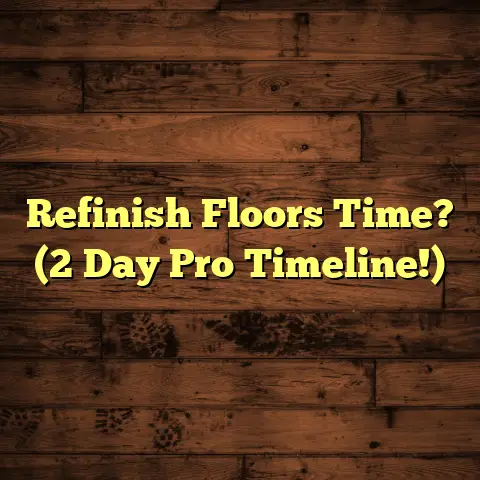Drill Laminate? STOP! Read This First! (7 Cracks Fixed!)
I’m excited to share my knowledge and experience.
I have spent 20+ years as a flooring contractor.
I’ve seen it all, from DIY triumphs to total flooring fails!
I’m talking about those moments when a well-intentioned.
DIY project goes south faster than you can say “oops!”
One of the biggest culprits? Drilling into laminate flooring without a second thought.
Trust me, I get it. You’re hanging a picture, installing a shelf, or running a cable, and the laminate floor is just there.
It seems like the perfect spot, right?
Wrong!
Before you even think about reaching for that drill, let’s pump the brakes.
Drilling into laminate can be a recipe for disaster, leading to cracks, chips, and a whole lot of frustration.
I’m here to arm you with the knowledge to avoid those costly mistakes and confidently tackle your flooring projects.
Think of this as your ultimate guide to understanding laminate, avoiding drilling disasters, and fixing those pesky cracks if they do happen to appear.
We’ll dive into the world of laminate flooring.
We’ll understand its composition, explore the risks of drilling, and learn how to fix the 7 most common types of cracks.
Let’s get started!
Section 1: Understanding Laminate Flooring
What is Laminate Flooring?
Laminate flooring has become a staple in modern homes.
It is a cost-effective, durable, and aesthetically pleasing alternative to hardwood.
But where did it come from?
Laminate flooring first emerged in Sweden in the 1970s as a response to the rising cost of real wood.
It quickly gained popularity in Europe and North America due to its affordability and ease of installation.
Today, it’s a go-to choice for homeowners looking to upgrade their floors without breaking the bank.
But what exactly is laminate flooring?
It’s a multi-layered synthetic flooring product fused together through a lamination process.
Let’s break down those layers:
-
Wear Layer: This is the top layer, a transparent, protective coating that resists scratches, stains, and fading.
-
Design Layer: This is a high-resolution photographic image that mimics the look of real wood, stone, or tile.
-
Core Layer: This is the heart of the laminate, typically made of high-density fiberboard (HDF) or medium-density fiberboard (MDF). It provides stability and impact resistance.
-
Backing Layer: This is the bottom layer, providing moisture resistance and structural balance.
The beauty of laminate lies in its ability to replicate the look of more expensive materials at a fraction of the cost.
Plus, it’s relatively easy to install, making it a popular choice for DIYers.
Common Issues with Laminate Flooring
While laminate is durable, it’s not invincible.
I’ve seen my fair share of laminate flooring woes over the years.
Here are some of the most common issues homeowners face:
-
Warping: This is often caused by moisture exposure. When laminate absorbs water, it can swell and warp, leading to uneven surfaces.
-
Cracking: This can be caused by impact, heavy furniture, or improper installation.
-
Gaps: These can form between planks due to temperature and humidity changes, or improper installation.
-
Scratches: While the wear layer is designed to resist scratches, it’s not bulletproof.
Heavy foot traffic, pets, and dragging furniture can all cause scratches.
-
Fading: Prolonged exposure to sunlight can cause the design layer to fade over time.
Regular maintenance is key to preventing these problems.
I always advise my clients to:
- Clean spills immediately.
- Use furniture pads under heavy items.
- Maintain a consistent indoor temperature and humidity level.
- Regularly sweep or vacuum to remove dirt and debris.
By keeping an eye on your laminate and addressing issues early, you can extend its lifespan and keep it looking its best.
Section 2: The Risks of Drilling into Laminate
Why Drilling is a Concern
Okay, let’s get to the heart of the matter: why is drilling into laminate such a big deal?
I get it; it seems like a quick and easy solution.
But trust me, it can open a can of worms.
The structural integrity of laminate flooring is dependent on its layered construction.
Each layer plays a crucial role in its overall strength and stability.
When you drill into laminate, you’re essentially disrupting this carefully engineered system.
Here’s what can happen:
-
Compromising the Core: The core layer, usually made of HDF or MDF, is the backbone of the laminate.
Drilling into it weakens its structural integrity, making it more susceptible to cracking and damage.
-
Creating Stress Points: Drilling can create stress points around the hole, which can lead to cracks radiating outwards over time.
-
Damaging the Wear Layer: The wear layer is designed to protect the laminate from scratches and stains.
Drilling through it can create a weak spot, making the laminate more vulnerable to damage.
-
Voiding the Warranty: Many laminate flooring manufacturers have specific guidelines about modifications to the flooring.
Drilling into the laminate can void your warranty, leaving you on the hook for any repairs.
I’ve seen countless cases where a simple drilling job turned into a major flooring repair.
It’s just not worth the risk!
Understanding the Types of Cracks
Now, let’s talk about the different types of cracks that can occur when you drill into laminate.
Knowing what kind of crack you’re dealing with is crucial for determining the best course of action.
Here are some of the most common types of cracks I’ve seen:
-
Surface Cracks: These are shallow cracks that only affect the wear layer. They’re often caused by minor impacts or scratches.
-
Gaps Between Planks: These aren’t technically cracks, but they can be exacerbated by drilling near the edges of planks.
-
Deep Cracks: These cracks penetrate the core layer, compromising the structural integrity of the laminate.
-
Corner Cracks: These occur at the corners of planks, often near where they meet the wall or other flooring.
-
Buckling Cracks: These are caused by moisture absorption, leading to the laminate swelling and cracking.
-
Cracks from Moisture: Similar to buckling cracks, these are caused by prolonged exposure to moisture.
-
Cracks Caused by Heavy Furniture: These occur when heavy furniture puts excessive pressure on the laminate, especially around drilled holes.
To help you visualize these cracks, here’s a simple table:
| Crack Type | Description | Cause |
|---|---|---|
| Surface Cracks | Shallow cracks affecting only the wear layer | Minor impacts, scratches |
| Gaps Between Planks | Spaces between planks | Temperature changes, humidity, improper installation, drilling near edges |
| Deep Cracks | Cracks penetrating the core layer | Heavy impacts, drilling |
| Corner Cracks | Cracks at the corners of planks | Stress concentration, drilling near corners |
| Buckling Cracks | Cracks caused by swelling due to moisture | Moisture absorption |
| Cracks from Moisture | General cracks caused by prolonged moisture exposure | Prolonged moisture exposure |
| Cracks from Furniture | Cracks caused by excessive pressure from heavy furniture, especially near drilled holes | Heavy furniture |
Understanding the type of crack you’re dealing with will help you choose the right repair method.
In the next section, we’ll dive into how to fix these common cracks!
Section 3: The 7 Common Cracks and How to Fix Them
Alright, let’s get practical!
I’m going to walk you through the 7 most common types of laminate cracks and how to fix them.
I’ll provide you with step-by-step instructions, tool recommendations, and insider tips to get your floors looking their best.
Crack 1: Surface Cracks
Surface cracks are the easiest to deal with.
They usually only affect the wear layer and don’t compromise the structural integrity of the laminate.
Cause: Minor impacts, scratches, or scuffs.
How to Fix:
-
Clean the Area: Use a damp cloth to clean the area around the crack. Make sure it’s free of dirt and debris.
-
Apply a Laminate Repair Kit: You can find these kits at most home improvement stores. They usually include a color-matched filler and a tool for applying it.
-
Fill the Crack: Carefully apply the filler to the crack, making sure to fill it completely.
-
Smooth the Surface: Use the tool provided in the repair kit to smooth the surface of the filler.
-
Let it Dry: Allow the filler to dry completely according to the manufacturer’s instructions.
-
Buff the Area: Use a soft cloth to buff the area and blend the repair with the surrounding laminate.
Tools and Materials Needed:
- Damp cloth
- Laminate repair kit
- Soft cloth
Pro Tip: When choosing a laminate repair kit, try to find one that closely matches the color and texture of your flooring.
Crack 2: Gaps Between Planks
Gaps between planks can be unsightly and can also allow moisture to seep into the core layer.
Cause: Temperature and humidity changes, improper installation, or drilling near the edges of planks.
How to Fix:
-
Identify the Cause: Determine why the gap is forming. Is it due to seasonal changes, or is there an underlying moisture problem?
-
Clean the Area: Use a vacuum cleaner to remove any dirt or debris from the gap.
-
Use a Laminate Floor Gap Filler: These fillers are designed to fill small gaps between planks.
-
Apply the Filler: Carefully apply the filler to the gap, making sure to fill it completely.
-
Smooth the Surface: Use a putty knife or your finger to smooth the surface of the filler.
-
Let it Dry: Allow the filler to dry completely according to the manufacturer’s instructions.
-
Consider Refitting Planks: If the gap is large, you may need to remove the affected planks and refit them.
This can be a bit more involved, so you may want to consult a professional.
Tools and Materials Needed:
- Vacuum cleaner
- Laminate floor gap filler
- Putty knife
- Soft cloth (optional)
Pro Tip: To prevent gaps from forming in the first place, make sure to acclimate your laminate flooring to the room’s temperature and humidity before installation.
Crack 3: Deep Cracks
Deep cracks are a serious issue because they compromise the structural integrity of the laminate.
Cause: Heavy impacts, drilling, or excessive weight.
How to Fix:
-
Assess the Damage: Determine the extent of the crack. Is it just a surface crack, or does it penetrate the core layer?
-
Clean the Area: Use a vacuum cleaner to remove any dirt or debris from the crack.
-
Apply Wood Glue: Carefully apply wood glue to the crack, making sure to get it deep into the core layer.
-
Clamp the Area: Use clamps to hold the planks together while the glue dries.
-
Let it Dry: Allow the glue to dry completely according to the manufacturer’s instructions.
-
Remove the Clamps: Remove the clamps and inspect the repair.
-
Apply a Laminate Repair Kit: Use a laminate repair kit to fill any remaining gaps or imperfections.
-
Smooth the Surface: Use the tool provided in the repair kit to smooth the surface of the filler.
-
Let it Dry: Allow the filler to dry completely according to the manufacturer’s instructions.
-
Buff the Area: Use a soft cloth to buff the area and blend the repair with the surrounding laminate.
Tools and Materials Needed:
- Vacuum cleaner
- Wood glue
- Clamps
- Laminate repair kit
- Soft cloth
Pro Tip: For deep cracks, it’s important to use a high-quality wood glue that will bond the layers of laminate together effectively.
Crack 4: Corner Cracks
Corner cracks can be tricky because they’re often located in high-stress areas.
Cause: Stress concentration, drilling near corners, or impact.
How to Fix:
-
Clean the Area: Use a damp cloth to clean the area around the crack. Make sure it’s free of dirt and debris.
-
Apply Wood Glue: Carefully apply wood glue to the crack, making sure to get it deep into the core layer.
-
Clamp the Area: Use clamps to hold the corner together while the glue dries. You may need to get creative with the clamps to ensure they’re holding the corner securely.
-
Let it Dry: Allow the glue to dry completely according to the manufacturer’s instructions.
-
Remove the Clamps: Remove the clamps and inspect the repair.
-
Apply a Laminate Repair Kit: Use a laminate repair kit to fill any remaining gaps or imperfections.
-
Smooth the Surface: Use the tool provided in the repair kit to smooth the surface of the filler.
-
Let it Dry: Allow the filler to dry completely according to the manufacturer’s instructions.
-
Buff the Area: Use a soft cloth to buff the area and blend the repair with the surrounding laminate.
Tools and Materials Needed:
- Damp cloth
- Wood glue
- Clamps
- Laminate repair kit
- Soft cloth
Pro Tip: For corner cracks, it’s important to use clamps that can apply even pressure to the corner.
Crack 5: Buckling Cracks
Buckling cracks are a sign of moisture damage.
Cause: Moisture absorption, leading to the laminate swelling and cracking.
How to Fix:
-
Identify the Source of Moisture: Find the source of the moisture and address it. This could be a leaky pipe, a damp basement, or poor ventilation.
-
Remove the Affected Planks: Carefully remove the buckled planks. You may need to use a pry bar to gently lift them up.
-
Dry the Subfloor: Make sure the subfloor is completely dry before replacing the planks. You may need to use a dehumidifier or fan to speed up the drying process.
-
Replace the Planks: Replace the buckled planks with new ones. Make sure to use the same type of laminate flooring to ensure a seamless match.
-
Seal the Edges: Seal the edges of the planks with a waterproof sealant to prevent future moisture damage.
Tools and Materials Needed:
- Pry bar
- Dehumidifier or fan (optional)
- New laminate planks
- Waterproof sealant
Pro Tip: To prevent buckling cracks, make sure to keep your laminate flooring dry and well-ventilated.
Crack 6: Cracks from Moisture
Similar to buckling cracks, these are caused by prolonged exposure to moisture.
Cause: Prolonged moisture exposure.
How to Fix:
-
Identify the Source of Moisture: Find the source of the moisture and address it. This could be a leaky pipe, a damp basement, or poor ventilation.
-
Remove the Affected Planks: Carefully remove the damaged planks. You may need to use a pry bar to gently lift them up.
-
Dry the Subfloor: Make sure the subfloor is completely dry before replacing the planks. You may need to use a dehumidifier or fan to speed up the drying process.
-
Replace the Planks: Replace the damaged planks with new ones. Make sure to use the same type of laminate flooring to ensure a seamless match.
-
Seal the Edges: Seal the edges of the planks with a waterproof sealant to prevent future moisture damage.
Tools and Materials Needed:
- Pry bar
- Dehumidifier or fan (optional)
- New laminate planks
- Waterproof sealant
Pro Tip: To prevent moisture-related cracks, make sure to clean up spills immediately and avoid using excessive water when cleaning your laminate flooring.
Crack 7: Cracks Caused by Heavy Furniture
These occur when heavy furniture puts excessive pressure on the laminate, especially around drilled holes.
Cause: Heavy furniture.
How to Fix:
-
Remove the Furniture: Remove the heavy furniture from the affected area.
-
Assess the Damage: Determine the extent of the crack. Is it just a surface crack, or does it penetrate the core layer?
-
Clean the Area: Use a vacuum cleaner to remove any dirt or debris from the crack.
-
Apply Wood Glue: Carefully apply wood glue to the crack, making sure to get it deep into the core layer.
-
Clamp the Area: Use clamps to hold the planks together while the glue dries.
-
Let it Dry: Allow the glue to dry completely according to the manufacturer’s instructions.
-
Remove the Clamps: Remove the clamps and inspect the repair.
-
Apply a Laminate Repair Kit: Use a laminate repair kit to fill any remaining gaps or imperfections.
-
Smooth the Surface: Use the tool provided in the repair kit to smooth the surface of the filler.
-
Let it Dry: Allow the filler to dry completely according to the manufacturer’s instructions.
-
Buff the Area: Use a soft cloth to buff the area and blend the repair with the surrounding laminate.
-
Use Furniture Pads: Place furniture pads under the legs of heavy furniture to distribute the weight more evenly.
Tools and Materials Needed:
- Vacuum cleaner
- Wood glue
- Clamps
- Laminate repair kit
- Soft cloth
- Furniture pads
Pro Tip: To prevent cracks caused by heavy furniture, use furniture pads and avoid placing excessive weight on your laminate flooring.
Section 4: Preventative Measures to Avoid Cracking
Prevention is always better than cure!
I always tell my clients that taking preventative measures is the best way to avoid laminate flooring problems in the first place.
Here are some tips to keep your laminate looking its best:
Choosing the Right Tools
Having the right tools can make all the difference when it comes to installing and maintaining laminate flooring.
Here are some essential tools to have on hand:
- Measuring Tape: Essential for accurate measurements.
- Pencil: For marking cut lines.
- Laminate Cutter: For clean, precise cuts.
- Tapping Block: For gently tapping planks into place.
- Pull Bar: For pulling planks together in tight spaces.
- Spacers: For maintaining consistent expansion gaps.
- Hammer: For tapping the tapping block.
- Safety Glasses: For protecting your eyes.
- Knee Pads: For protecting your knees.
Proper Installation Techniques
Proper installation is crucial for preventing future damage.
Here are some essential installation practices:
-
Acclimate the Flooring: Allow the laminate flooring to acclimate to the room’s temperature and humidity for at least 48 hours before installation.
-
Prepare the Subfloor: Make sure the subfloor is clean, level, and dry.
-
Use an Underlayment: Install an underlayment to provide cushioning, moisture protection, and sound insulation.
-
Maintain Expansion Gaps: Leave a small expansion gap around the perimeter of the room to allow for natural expansion and contraction.
-
Follow Manufacturer Guidelines: Always follow the manufacturer’s installation instructions.
Maintenance Tips
Regular maintenance is key to keeping your laminate flooring in optimal condition.
Here’s a maintenance schedule you can follow:
- Daily: Sweep or vacuum to remove dirt and debris.
- Weekly: Damp mop with a laminate floor cleaner.
- Monthly: Inspect for any signs of damage, such as scratches, cracks, or gaps.
- As Needed: Clean up spills immediately.
Section 5: Conclusion: Empowering Homeowners for Future Projects
Congratulations! You’ve made it to the end of this comprehensive guide to laminate flooring cracks.
You’re now equipped with the knowledge and skills to tackle your flooring projects with confidence.
Remember, drilling into laminate can be risky, but with the right precautions and techniques, you can avoid costly mistakes and achieve a beautiful, long-lasting finish.
I encourage you to approach your laminate flooring with knowledge and care.
Understanding the potential pitfalls and solutions can make all the difference in the outcome of your project.
And if you ever find yourself facing a flooring challenge, don’t hesitate to consult a professional.
We’re here to help!
Happy flooring!





